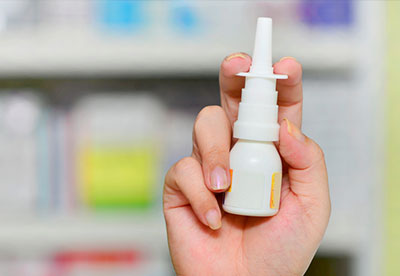Intranasal Esketamine Found to Be Safe, Effective but Questions Remain

An intranasal form of esketamine plus a newly prescribed antidepressant appears to be safe and significantly more effective than placebo plus antidepressant in reducing symptoms in patients with treatment-resistant depression, according to a report in the American Journal of Psychiatry released on Tuesday at the Annual Meeting.
Patients receiving either 56 mg or 84 mg of intranasal esketamine plus an antidepressant experienced significantly greater improvement in depression scores at 28 days and a meaningful improvement in symptoms 24 hours after the first esketamine dose. Esketamine is the s-enantiomer of ketamine, which is composed of two mirror image molecules. Ketamine has been used as an anesthetic since 1970. Esketamine can be administered as a spray intranasally in relatively small doses to deliver a very rapid therapeutic effect and was recently approved by the Food and Drug Administration for treatment-resistant depression in adults.
The findings add to the “buzz” around an agent that has received an enormous amount of attention in the last several years as a potentially fast-acting medication for treatment-resistant depression. Yet caution also surrounds esketamine because of its abuse potential (ketamine has been used for years as a recreational drug) and because of unanswered questions about the length of time it should be used and the possible adverse effects of long-term use.
Past APA President Alan Schatzberg, M.D., an internationally recognized expert on depression whose research has focused on treatment-resistant depression, struck a tone of muted optimism in an editorial accompanying the report.
“[T]here are more questions than answers with intranasal esketamine, and care should be exercised in its application in clinical practice,” Schatzberg wrote. “Still, the agent could be helpful to many patients with refractory depression, and efforts to develop rapidly acting agents for severely depressed patients need to be applauded.”
In this phase 3 study conducted at 39 outpatient centers, 223 adults with treatment-resistant depression received an antidepressant plus either esketamine nasal spray (56 mg or 84 mg twice weekly) or placebo nasal spray. Treatment resistance was defined as having failed to respond to at least two separate antidepressant regimens.
Investigators used the Montgomery-Åsberg Depression Rating Scale (MADRS) to measure changes in symptoms of depression. The primary efficacy measure was change after 28 days of treatment.
Both esketamine and placebo were provided in disposable, nasal spray devices with identical appearance and packaging to prevent participants and researchers from knowing which participants were taking esketamine. For antidepressant treatment, the investigator could select from four different options: one of two selective serotonin reuptake inhibitors (escitalopram or sertraline) or one of two serotonin and norepinephrine reuptake inhibitors (duloxetine or venlafaxine extended release). The investigator chose the antidepressant based on a review of the patient’s Massachusetts General Hospital Antidepressant Treatment Response Questionnaire and antidepressant treatment history.
Participants in the esketamine plus antidepressant group experienced a significantly greater improvement in mean MADRS score after 28 days of treatment, as compared with the antidepressant plus placebo group.
Moreover, early response (as defined by at least a 50% decrease in MADRS score by day 2) was observed in 16.5% of patients in the esketamine plus antidepressant group, compared with 10.8% of patients in the comparator group.
Regarding safety, 7% of patients in the esketamine group discontinued the drug because of an adverse event compared with 0.9% in the placebo group. Adverse events in the esketamine plus antidepressant group generally appeared shortly after dosing and resolved by 1.5 hours after taking the medication, according to the authors.
Schatzberg, in his editorial accompanying the study, emphasized questions surrounding the optimal length of time to use a drug whose long-term effects are largely unknown. “Since the patients were treated with the combination of an active antidepressant plus either esketamine or placebo, the data make one wonder whether one really needs to continue esketamine beyond initial use,” he wrote. “Why not use it only once or twice for 1 or 2 weeks rather than twice weekly for 4 weeks? This question needs to be considered in the context of what ketamine is—an anesthetic agent that has been abused in this country and elsewhere in various formulations.”
In conclusion Schatzberg asked, “So, where are we? Intranasal esketamine represents an easier method of administration than intravenous administration of ketamine. Do we have clear evidence of efficacy? Maybe? How strong is the efficacy? Apparently mild. Do we have a real sense of how long and how often to prescribe it? It’s not entirely clear. If patients lose response, should we increase the frequency of administration? This could be problematic. Can coming off the drug be problematic? Data suggest that it could be an issue. … Only time will tell how useful it will be.”
The study was funded by Janssen Research and Development.
(Image: iStock/MJ_prototype)
|
|
|
|
|


